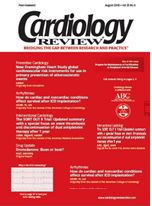Dual antiplatelet therapy superior to monotherapy in reducing embolization in stroke patients
Stroke
Dual antiplatelet therapy with clopidogrel (Plavix) and aspirin produces a more rapid reduction in asymptomatic embolization compared with aspirin alone in patients with recently symptomatic carotid stenosis.
Asymptomatic microembolic signals (MES) detected by transcranial Doppler ultrasound serve as a surrogate marker for the risk of future stroke or transient ischemic attack (TIA).
The findings emerged from an international study called Clopidogrel and Aspirin for Reduction of Emboli in Symptomatic carotid Stenosis (CARESS), a randomized, double-blind clinical trial assessing the efficacy of antiplatelet agents in reducing the incidence of MES in the middle cerebral artery as detected by transcranial Doppler. The investigational team was led by Hugh S. Markus, FRCP, professor of neurology at St. George’s Hospital Medical School in London, United Kingdom.
As reported in Circulation (2005;111
[17]:2233-2240), CARESS enrolled 107 participants at 11 medical centers in France, Germany, Switzerland, and the United Kingdom. All patients had 50% or greater carotid stenosis. To be eligible, patients had to have suffered a stroke or TIA within the 3 months before enrollment. They were randomly assigned to 7 days of aspirin monotherapy, 75 mg/day, or aspirin plus clopidogrel, a 300-mg loading dose on day 1 followed by 75 mg/day.
Recent studies have suggested that the risk of a very early recurrent stroke after a minor stroke or TIA may be as high as 8% to 12% at 7 days.
“The risk is particularly high in patients with narrowed carotid arteries, which suggests that more aggressive anticlotting therapy may be indicated in this patient group,” according to Dr. Markus.
After 7 days, MES were detected in 43.8% of the patients receiving dual therapy compared with 72.7% of the group treated with aspirin only—a relative risk reduction of 39.8% (P = .005).
“The results demonstrate the power of the technique to detect treatment effects in relatively small groups of patients, far less than those required with the use of clinical end points such as stroke, and suggest this technique may help screen different drug combinations for further testing in large and expensive clinical trials,” he added.
A secondary end point—MES frequency per hour—was reduced by 61.4% with dual therapy at day 7 (P = .001) and by 61.6% at day 2 (P = .005).
No significant difference in bleeding was observed between the two groups, with no episodes of life-threatening, major, or intracerebral hemorrhage in either group. There were three minor bleeding events—two in the group assigned to dual therapy and one in patients assigned to aspirin alone.
Although aspirin is commonly prescribed to prevent recurrent strokes or TIAs caused by emboli, it prevents recurrent strokes in only about one fifth of the patients treated.
A recent clinical trial found no additional benefit of dual therapy over monotherapy in the secondary prevention of stroke over 18 months of follow-up in patients with either large-vessel or small-vessel disease, but patients were recruited several weeks after the acute phase of their strokes, the CARESS authors note. “The results of CARESS suggest that dual antiplatelet therapy with clopidogrel and aspirin is likely to be more effective in patients with large-vessel atherosclerotic stroke in the acute phase,” they write.
